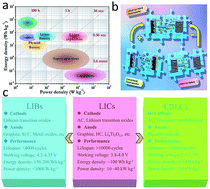Non-aqueous dual-carbon lithium-ion capacitors: a review
Abstract
By reducing the gap between lithium-ion batteries (LIBs) and supercapacitors (SCs) effectively, lithium-ion capacitors (LICs) have attracted tremendous attention among various electrochemical energy storage systems because they exhibit a high energy density (inherited from the LIBs), a high power output, long lifespan (owing to the SCs) and favorable chemical stability. Carbonaceous electrode materials play significant roles in high performance dual-carbon LICs whether positive or negative. Here, the working mechanism, cell design principle and recent progress in carbon-based electrode materials for dual-carbon LICs are illustrated. Then, the commercialization of LICs is discussed briefly. Finally, some suggestions for the future developments associated with dual-carbon LICs are proposed.

- This article is part of the themed collection: Recent Review Articles


 Please wait while we load your content...
Please wait while we load your content...